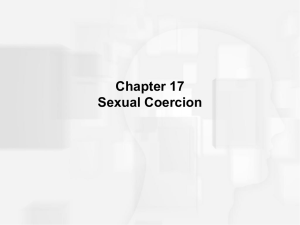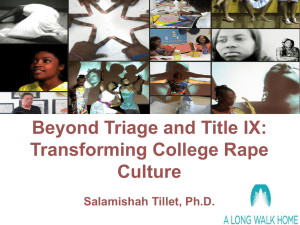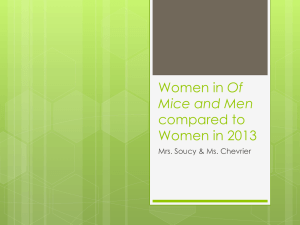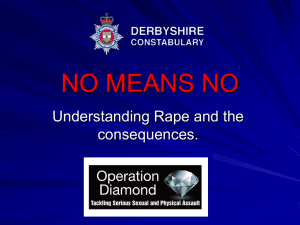three times more likely to commit sexual assault
advertisement
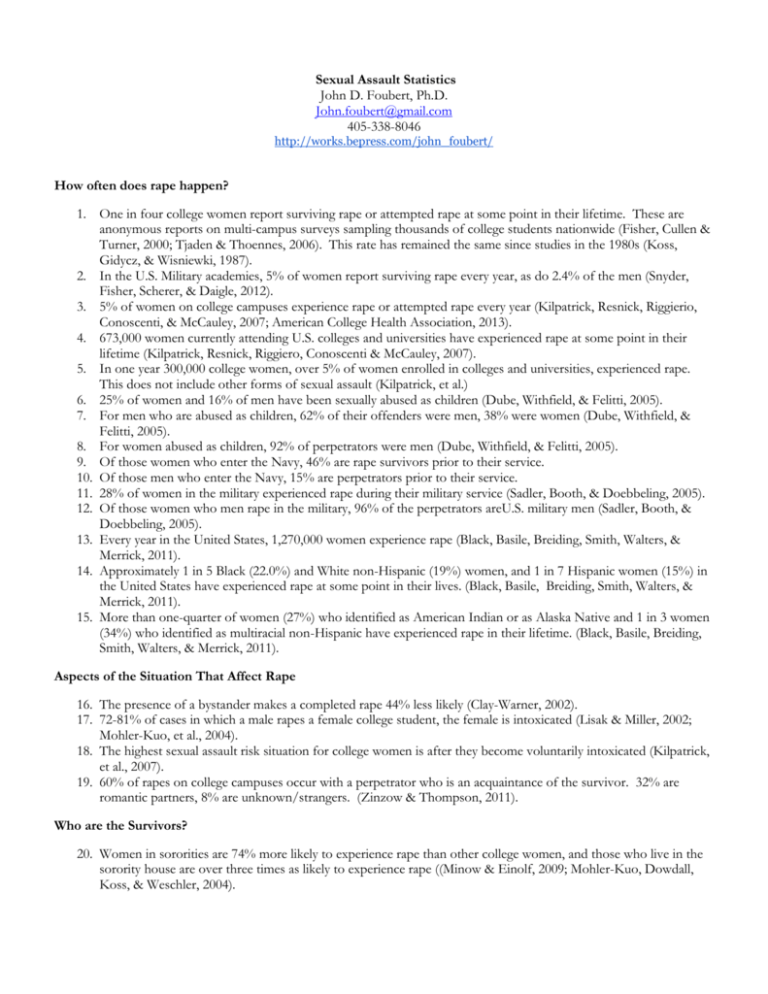
Sexual Assault Statistics John D. Foubert, Ph.D. John.foubert@gmail.com 405-338-8046 http://works.bepress.com/john_foubert/ How often does rape happen? 1. One in four college women report surviving rape or attempted rape at some point in their lifetime. These are anonymous reports on multi-campus surveys sampling thousands of college students nationwide (Fisher, Cullen & Turner, 2000; Tjaden & Thoennes, 2006). This rate has remained the same since studies in the 1980s (Koss, Gidycz, & Wisniewki, 1987). 2. In the U.S. Military academies, 5% of women report surviving rape every year, as do 2.4% of the men (Snyder, Fisher, Scherer, & Daigle, 2012). 3. 5% of women on college campuses experience rape or attempted rape every year (Kilpatrick, Resnick, Riggierio, Conoscenti, & McCauley, 2007; American College Health Association, 2013). 4. 673,000 women currently attending U.S. colleges and universities have experienced rape at some point in their lifetime (Kilpatrick, Resnick, Riggiero, Conoscenti & McCauley, 2007). 5. In one year 300,000 college women, over 5% of women enrolled in colleges and universities, experienced rape. This does not include other forms of sexual assault (Kilpatrick, et al.) 6. 25% of women and 16% of men have been sexually abused as children (Dube, Withfield, & Felitti, 2005). 7. For men who are abused as children, 62% of their offenders were men, 38% were women (Dube, Withfield, & Felitti, 2005). 8. For women abused as children, 92% of perpetrators were men (Dube, Withfield, & Felitti, 2005). 9. Of those women who enter the Navy, 46% are rape survivors prior to their service. 10. Of those men who enter the Navy, 15% are perpetrators prior to their service. 11. 28% of women in the military experienced rape during their military service (Sadler, Booth, & Doebbeling, 2005). 12. Of those women who men rape in the military, 96% of the perpetrators areU.S. military men (Sadler, Booth, & Doebbeling, 2005). 13. Every year in the United States, 1,270,000 women experience rape (Black, Basile, Breiding, Smith, Walters, & Merrick, 2011). 14. Approximately 1 in 5 Black (22.0%) and White non-Hispanic (19%) women, and 1 in 7 Hispanic women (15%) in the United States have experienced rape at some point in their lives. (Black, Basile, Breiding, Smith, Walters, & Merrick, 2011). 15. More than one-quarter of women (27%) who identified as American Indian or as Alaska Native and 1 in 3 women (34%) who identified as multiracial non-Hispanic have experienced rape in their lifetime. (Black, Basile, Breiding, Smith, Walters, & Merrick, 2011). Aspects of the Situation That Affect Rape 16. The presence of a bystander makes a completed rape 44% less likely (Clay-Warner, 2002). 17. 72-81% of cases in which a male rapes a female college student, the female is intoxicated (Lisak & Miller, 2002; Mohler-Kuo, et al., 2004). 18. The highest sexual assault risk situation for college women is after they become voluntarily intoxicated (Kilpatrick, et al., 2007). 19. 60% of rapes on college campuses occur with a perpetrator who is an acquaintance of the survivor. 32% are romantic partners, 8% are unknown/strangers. (Zinzow & Thompson, 2011). Who are the Survivors? 20. Women in sororities are 74% more likely to experience rape than other college women, and those who live in the sorority house are over three times as likely to experience rape ((Minow & Einolf, 2009; Mohler-Kuo, Dowdall, Koss, & Weschler, 2004). 21. Frequent, heavy episodic drinking increases college women’s chances of experiencing rape by eight-fold (MohlerKuo et al., 2004). 22. The more that a woman can recognize threatening cues in a situation that could turn into a sexual assault situation, the more likely she can resist or escape (Turchik, Probst, Chau, Nigoff, & Gidycz, 2007). Who are the Perpetrators? 23. For female rape survivors, 98.1% of the time a man was the perpetrator (Black, Basile, Breiding, Smith, Walters, & Merrick, 2011). 24. For male rape survivors, 93% of the time, a man was the perpetrator (Black, Basile, Breiding, Smith, Walters, & Merrick, 2011). 25. Among male offenders who rape women, 64% were using alcohol and/or drugs prior to the attack (Brecklin & Ullman, 2002). 26. Two different longitudinal studies have found that fraternity men are three times more likely to commit sexual assault than other college men (Foubert, Newberry, & Tatum, 2007; Loh, Gidycz, Lobo, & Luthra, 2005.) 27. Rapists are almost always (98%) men (Sedgwick, 2006). 28. College men who consume alcohol two or more times a week and had friends who support physical and emotional abuse of women are nine times more likely to commit sexual assault than men with none of these characteristics (DeKeseredy & Schwartz, 2014). 29. 9% of college men admit to acts meeting the legal definition of either rape or attempted rape (Abbey & McAuslan, 2004). 30. Perpetrators are extremely adept at identifying “likely” victims and testing prospective victims’ boundaries. (Lisak & Miller, 2002). 31. Perpetrators plan and premeditate their attacks, using sophisticated strategies to groom their victims for attack, and to isolate them physically (Lisak & Miller, 2002). 32. Perpetrators use alcohol deliberately to render victims more vulnerable to attack, or completely unconscious (Lisak & Miller, 2002). 33. Perpetrators view women as sexual objects to be conquered, coerced and used for self-gratification (Lisak & Miller, 2002). 34. Perpetrators easily feel slighted by women, and carry grudges against them. This underlying hostility is easily evoked and leads them to see women as “teases” who either “secretly” want to be coerced into sex, or else “deserve” it (Lisak & Miller, 2002). 35. Perpetrators view sexual relations as “conquests,” and all women as potential “targets” of conquests (Lisak & Miller, 2002). 36. Perpetrators tend to be part of sexually violent all-male subcultures that normalize sexual conquests through violent pornography explicit images of rape as being acceptable, non-criminal, and the sign of male virility (Lisak & Miller, 2002). What happens after the rape? 37. Approximately 11% of college women who experience rape report it to the police (Kilpatrick, et al., 2007). 38. 7% of college women who experience drug, alcohol, or incapacitated rape report it to the police. (Kilpatrick, et al., 2007). 39. Of those cases reported to the police, less than 10% of rape cases result in criminal charges against a defendant (Alderden & Ullman, 2012). 40. Survivors are significantly more likely than women in the general population to suffer from Post Traumatic Stress Disorder (McFarlane, Malecha, Watson, Gist, Batten, Hall, & Smith, 2005); in fact, rape survivors are the largest population in the nation with PTSD (Campbell & Wasco, 2005). 41. Rape is the least reported of all violent crimes (Rand, 2009). 42. The most common person a female survivor tells about what happened to her is a friend (Ahrens, Campbell, Ternier-Thames, Wasco, & Sefl, 2007). Prevention 43. High-risk men who see The Men’s Program commit 40% fewer sexual assaults than high risk men who are untreated (Foubert, 2011; Foubert, Newberry & Tatum, 2007). 44. High risk men who see The Men’s Program and who do commit sexual violence, commit acts that are 8 times less severe than untreated men (Foubert, 2011; Foubert, Newberry & Tatum, 2007). 45. College students who see The Men’s Program are more likely to intervene as a bystander to help prevent rape (Langhinrichsen-Rohling, Foubert, Brasfield, Hill, & Shelley-Tremblay, 2011). 46. Men in the military who see The Men’s Program report lower likelihood of raping, lower likelihood of committing sexual assault, and higher levels of bystander intervention than untrated men (Foubert & Masin, 2012). References Abbey, A. & McAuslan, P. (2004). A longitudinal examination of male college students’ perpetration of sexual assault. Journal of Consulting and Clinical Psychology, 72, 5, 747-756. Ahrens, C. E., Campbell, R., Ternier-Thames, N. K., Wasco, S. M., & Sefl, T. (2007). Deciding whom to tell: Expectations and outcomes of rape survivors’ first disclosures. Psychology of Women Quarterly, 31, 38-49. Alderden, M.A. & Ullman, S.E. (2012). Creating a More Complete and Current Picture: Examining Police and Prosecutor Decision-Making When Processing Sexual Assault Cases. Violence Against Women, 18, 525-551. American College Health Association. American College Health Association – National College Health Assessment II: Reference Group Executive Summary Spring 2013. Hanover, MD: American College Health Association; 2013. Black, M.C., Basile, K.C., Breiding, M.J., Smith, S.G., Walters, M.L., Merrick, M.T., Chen, J., & Stevens, M.R. (2011). The National Intimate Partner and Sexual Violence Survey (NISVS): 2010 Summary Report. Atlanta, GA: National Center for Injury Prevention and Control, Centers for Disease Control and Prevention. Brecklin, L., & Ullman, S. (2002). The roles of victim and offender alcohol use in sexual assaults: Results from the national violence against women survey. Journal of Studies on Alcohol, 63, 57-63. Campbell, R. & Wasco, S. M. (2005). Understanding rape and sexual assault: 20 years of progress and future directions. Journal of Interpersonal Violence, 20, (1), 127-131. Clay-Warner, J. (2002). Avoiding rape: The effects of protective actions and situational factors on rape outcome. Violence and Victims, 17 (6), 691 – 705. DeKeseredy W.S. & Schwartz M. (2014). Male Peer Support and Violence Against Women: The History and Verification of a Theory. Boston, MA: Northeastern Series on Gender, Crime, and Law. Dube, A., Whitfield, B., Felitti, D.G. (2005). Long-term consequences of childhood sexual abuse by gender of victim. American Journal of Preventive Medicine, 28(5). Fisher, B. S., Cullen, F. T., & Turner, M. G. (2000). The sexual victimization of college women. Washington, DC: National Institute of Justice, US Department of Justice. Foubert, J.D. (2011). The men’s and women’s programs: Ending rape through peer education. New York: Routledge. Foubert, J.D. & Masin, R.C. (2012). Effects of The Men’s Program on U.S. Army soldiers’ intentions to commit and willingness to intervene to prevent rape: A pretest posttest study. Violence and Victims, 27 (6), 911-921. Foubert, J.D., Newberry, J.T., & Tatum, J.L. (2007). Behavior differences seven months later: Effects of a rape prevention program on first-year men who join fraternities. The Journal of Student Affairs Research and Practice, 44, 728-749. Kilpatrick, D.G., Resnick, H.S., Ruggierio, K.J., Conoscenti, L.M., & McCauley, J. (2007). Drug- facilitated, incapacitated, and forcible rape: a national study (NCJ 219181) Medical University of South Carolina, National Crime Victims Research & Treatment Center; Charleston, SC. Langhinrichsen-Rohling, J., Foubert, J.D., Brasfield, H., Hill, B., & Shelley-Tremblay, S. (2011). The Men’s Program: Does it impact college men’s bystander efficacy and willingness to intervene? Violence Against Women, 17 (6), 743-759. Lisak, D. & Miller, P. (2002). Repeat rape and multiple offending among undetected rapists. Violence and Victims, 17 (1), 73-84. McFarlane, J., Malecha, A., Watson, K., Gist, J., Batten, E., Hall, I., & Smith, S. (2005). Intimate partner sexual assault against women: Frequency, health consequences and treatment outcomes. Obstetrics & Gynecology, 105, 99-108. Minow, J. C., & Einolf, C. J. (2009). Sorority participation and sexual assault risk. Violence Against Women, 15(7), 835-851. Mohler-Kuo, M., Dowdall, G. W., Koss, M. P., & Wechsler, H. (2004). Correlates of rape while intoxicated in a national sample of college women. Journal of Studies on Alcohol, 65(1), 37-45. Rand, M. R. (2009). National Crime Victimization Survey: Criminal victimization, 2008. Washington, DC: Bureau of Justice Statistics, U.S. Department of Justice. Sadler, A. G., Booth, B. M., & Doebbeling, B. N. (2005). Gang and multiple rapes during military service: Health consequences and health care. Journal of the American Medical Women’s Association, 60(1), 33-41. Sedgwick, J. L. (2006). Criminal victimization in the United States, 2005 Statistical tables: National crime victimization survey. Washington, DC: U.S. Department of Justice, Bureau of Justice Statistics, NCJ 215244 Stander, V.A., Merrill, L.L., Thomsen, C.J., Crouch, J.L., & Milner, J.S. (2008). Premilitary adult sexual assault victimization and perpetration in a navy recruit sample. Journal of Interpersonal Violence, 23(11), 1636-1653. Tjaden, P. & Thoennes, N. (2006). Extent, nature and consequences of rape victimization: Findings from the national violence against women survey. Washington, DC: National Institute of Justice. Turchik, J. A., Probst, D. R., Chau, M., Nigoff, A., & Gidycz, C. A. (2007). Factors predicting the type of tactics used to resist sexual assault: A prospective study of college women. Journal of Consulting and Clinical Psychology, 75, 605-614. Zinzow, H.M. & Thompson, M. (2011). Barriers to reporting sexual victimization: Prevalence and correlates among undergraduate women. Journal of Aggression, Maltreatment, and Trauma, 20, 711-725.



